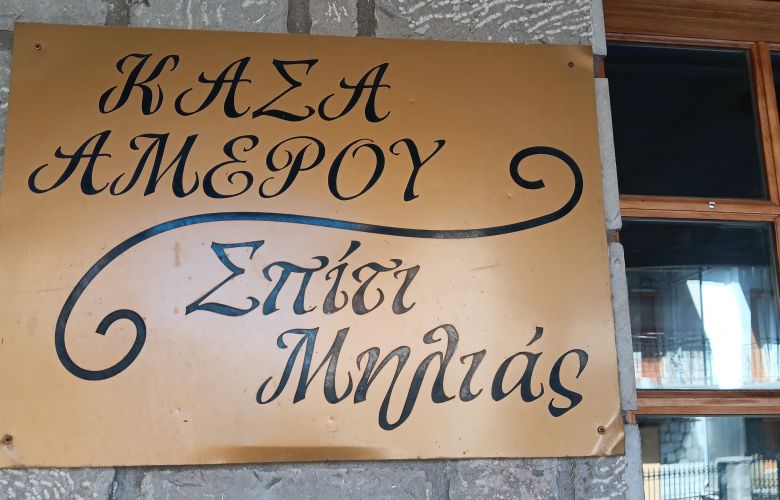Vlachochori is built at an altitude of 1,200 meters in Pindos
Milia Metsovo is Vlachohori, built at an altitude of 1,200 meters in Pindos. Usually, it is in the news, due to difficult weather conditions, long winter and small summer.
But its cobbled streets, stone houses, churches, its people, have to “tell” small stories that highlight the culture of the place.
The discussion in cafes is interesting. The traditional village, although in the mountains, is still alive, it has everyday life, in its alleys, children’s voices are heard, it has past, present and future, as its people told us.
Milia is 17 kilometers away from Metsovo.
The smoke that smokes in the stone café that has closed door and windows, because the cold is bitter, shows us the road as soon as we arrived.
A cast iron stove in the middle, old tables and chairs, a jukebox in a corner by the window, tsipouro with snacks and smiling, open -hearted people welcome us and talk about the stories of their little society.
Village
In the past, but even today, the village is referred to as Ameros. It is the name of Milia in the Vlach language, and in fact, the locals in discussions use the name of the American. The answer comes from the depth of time. As Deputy Mayor of Metsovo Theodoris Siotas told us, when the historic Egnatia Road passed outside the settlement to connect Metsovo with Grevena, there was a hani for travelers there. Next to his entrance, there was an apple tree, which became a reference point, a meeting and gave the name to the village.
Residents are willing to give us all the information about Milia, which has even been described as a preserved traditional settlement, was described in the RES.
The village of the wood carvings
From generation to generation the folk art of wood carving, continues and even gives the identity of the village. Mr. Dimitris Kyrgotasis, who we met in the café, sometimes president of Milia, tells us that workshops are present in all homes. Great craftsmen Miliots maintain about 40 laboratories and create beautiful wood carvings, decorative or useful objects that supply the market all over Greece. This is also the “secret” of the non -desolation of the village, which, although spreading to a 1,200 -meter -high slope at an altitude of 1,200 meters, has 180 inhabitants, including 27 children.
“We brought the current and the water to the village on our own. We all worked together, with personal work. In fact, 25 years ago we renewed the network. We all worked in the woods in the wood cooperative, we sold the woods and the money we received, we gave them to renew the water supply network, ”notes Thodoris Siotis, as a highlight, for his love Miliots in their place.
The historical church of Agios Nikolaos
As the visitor goes up to the settlement after the first houses he encounters two churches. The imposing Virgin Mary and a smaller stone -built St. Nicholas, patron saint of Milia. According to written inscriptions in the Catholic, the church of St. Nicholas appears to have probably been built on another older one, at the end of the 17th century and early 18th. Residents of Metsovo, Krania, Panagia, Malakassi, has always been on foot to worship. Mr. Siotis tells us, an important aspect of the story of the temple. During the German occupation, when the Nazis burned most of the village houses, they imprisoned the female children in the temple for a week. With the prayers in Agios Nikolaos and the oil from the candlesticks for food, women and children, they managed to survive.
For the inhabitants of not only the village, but also of the wider area, Agios Nikolaos is their miraculous saint. In the old days, people from the area, with mental illness, made them sit in the Holy Step of the Temple and prayed for their health. There, there are still the iron handles where they were tied to the patients so as not to leave.
The Folklore Museum
The inscription “AMERO-HOUSE-MILIAS” next to the entrance, a simple stone building, shows us the Folklore Museum. This is a guided tour of the daily lives of the inhabitants in the older times. A loom where woolen carpets, pillows, winter capes, female masts, which they call the Vlach tongues, beautifully woven and traditional costumes, admire the museum’s showcases. Wooden and home -made wooden items for the home, tools for the forest useful in logging, all made of human hands during the pre -industrial era, take us to the past.
The Bulvaru Waterfalls
Within a natural surrounding special beauty, the running water in its passage, carved the rocks. At a distance of 3 kilometers from Milia, on the road to the next village of Krania Grevena, nature reveals its secrets, the triple waterfall in the stream Boulouvaros. Our guide is a signposted small path of 100 meters in length, between the firs and the hum of water. The water that falls from the waterfalls forms small ponds, “Ovits as the locals call them, which offer breaths of coolness in the crystal clear waters during the summer months.
The bear landmark in Milia
When the visitor arrives at Milia, a small glass house, draws attention. The reason is the bear that lives in it and welcomes the world. And as it was natural, we asked in the cafe about her story. Evinous, Mr. Dimitris Kyrgotasis talks to us about her history in the distant 1992. Then, in the opposite village of Plagia in the location of Goumaritsou, a farmer found the female bear poisoned and dying. Everyone ran to help her and transported her with a farm to the square. They even called veterinarians to save her. But they failed to do so and decided to embrace her to stay in the village forever. Since then the bear is the Milia mascot.
After Metsovo, on the old road to Kalambaka that crosses the curse, in a magnificent natural landscape, meadows, spruce slopes, small rivers and a lot of oxygen, a sign that writes 12km apple meters leads us to the beautiful Vlachochori of Pindos.








